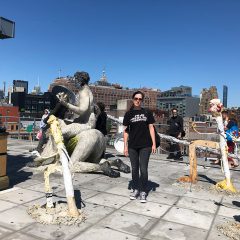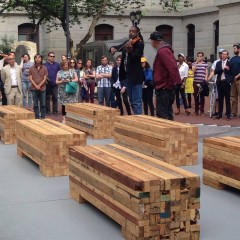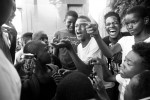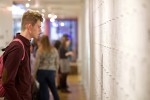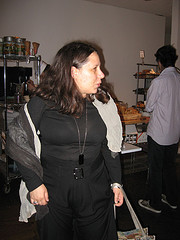
Zoe Strauss at the Whitney
Philadelphia photographer Zoe Strauss took personal control of her big night at the Whitney Museum Friday night, allowing an audience with a large Philadelphia contingent to bask in her personal warmth.
Zoe Strauss Night was part of the Whitney’s Independent Public Offerings series, and Zoe gave out 200 free photos to the 200 ticket-holders who got in the door.
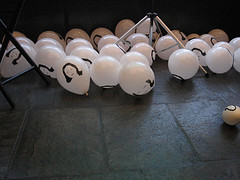
The decorations reminded me of birthday parties, bar mitzvahs and weddings. A puddle of white balloons emblazoned with Zoe’s face sat in front of the room. The same balloons fluttered around an arbor of lights–a setting for free portraits taken by a roving Polaroid photographer.
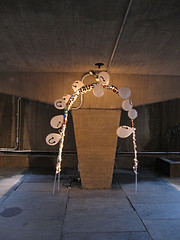
The arbor of lights and balloons for the Polaroid photos
On a table in the back, people were encouraged to trade their free photographs for others. Plastic bags filled with PAP and Philly campaign-style buttons as well as piles of Tastykakes awaited distribution, although I only saw the pink Philly buttons come around. PAP is Strauss’ 10-year public art project, in which each year she displays hundreds of her photographs on the pilasters supporting I-95 where it cuts through South Philadelphia.
Strauss herself was dressed in a fabulous Isaac Mizrahi outfit, the trophy from an Isaac Mizrahi tv makeover–her 15 minutes of fame beyond Philadelphia and the art world. An hour before the Whitney event, we saw Lynn, Strauss’ partner, at 57th and Madison, in the pouring rain with the Mizrahi outfit in a plastic bag draped over her arm. There was not a vacant cab in sight, thanks to the rain and the rush hour, so she was drenched and hoofing it uptown with the precious delivery.
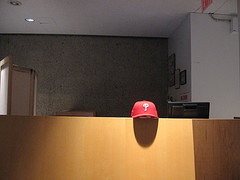
The Philadelphia presence was palpable
The event included three Zoe Strauss signature slide shows–which she explained were part of her method for figuring out the arrangement of the photos under I-95–and the trailer to a documentary about Strauss, “If You Break the Skin, You Must Come in,” taped over the summer by a group of young Philadelphians ( see the video here). They sat in the front row looking gorgeous and young and wonderful–and now they’ve had work in the Whitney, too!
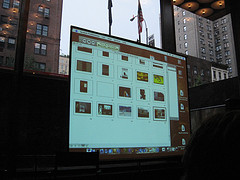
The projected computer page of Strauss photos fit right in with the buildings outside.
Here are some highlights of the series of “Dick Cavett” style chats that followed:
Zoe chats with Danielle Jackson
Danielle Jackson was introduced as a New York City cultural worker. Honest! Strauss greeted here with, “Yes, I love you Danielle Jackson.”
The chat centered on the language in Strauss’ photos–the corporate language of business and government, and the local language of hand-made signs and graffiti.
“I like it to be like you’re reading a long sentence, like you’re reading a palindrome,” said Strauss of how she hopes the language in her photographs works in the I-95 setting.
Jackson added that Strauss also manipulated words by cropping. Strauss said SAVE was actually cropped from a sign for the Save-A-Buck Thrift Store.
Zoe chats with Kate Ware
Zoe calls out: “Oh, look. It’s Kate Ware. It’s Kate Ware.”
Music swells in the background as Zoe intones: “And now, straight from the Philadelphia Museum of Art, Kath-e-rine Ware.”
Ware, the PMA’s curator of photographs, states that Zoe’s work finds the extraordinary in the ordinary, unlike William Eggleston, who photographs the ordinary as ordinary. She adds that while most contemporary photography is about the surface right now, Strauss’ work digs deep, and there’s a deep human connection, a moment that is fleeting but intimate.
Strauss comments, “The exchange that’s what’s really important to me.”
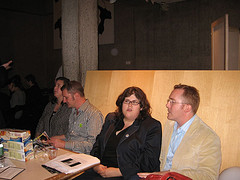
Interviewers Elyse Gonzales and Peter Barberie, with a glimpse of Kate Ware, left
Zoe chats with Elyse Gonzales
Zoe calls out: “Look who it is, my first curator. You never forget your first.”
Apparently Strauss did forget her first. Kate Ware interjected, “What about me?”
Strauss backpedaled, explaining that Gonzales was “…my first solo museum show curator.” ICA Assistant Curator Gonzales had curated Strauss’ ramp project solo show at the Institute of Contemporary Art in Philadelphia earlier this year.
The conversation began with the PAP I-95 project. “This was going to be my plan for my 30s,” said Strauss of her 10-year project, to end in 2010. The space under I-95 is “beautiful and interesting,” said Strauss, explaining her choice of venue. It’s outside. And it’s “in walking distance from my house.” She added it’s near commerce, and she liked the sound of the cars zooming by overhead. But most important, it’s a space that’s accessible, “that can be happened upon accidentally by anyone.”
Gonzales turned the conversation to the ICA ramp project. The photo in the window at the ICA ramp installation, the image of a woman smoking crack, was about desire, one of the important themes in Strauss’ work. And it was visible to casual passersby.
Zoe chats with Peter Barberie
I didn’t copy down her greeting for Peter Barberie, author of Looking at Atget (2005) and a Fellow in photography at the PMA, but it was also enthusiastic. He started by saying he would talk about who her work reminds him of–“but also her work is quite different.”
Strauss: “And I think you said quite better.”
Barberie: “That’s for history to decide”
He then compared her to Walker Evans, for the use of text and signs, and also for the interest in the serial relationship of the photographs to one another. He suggested she make a book, like Evans; she parried that she wanted someone else to write a book about her work–and she also wanted a museum retrospective.
Also on the list of comparisons:
Diane Arbus for creating a relationship with her subjects
Nan Goldin, for photographing her own milieu and also using slide shows
Tina Barney, also for photographing her own world (of the privileged Northeast, showing how people are like the houses they come from)
Carrie Mae Weems, her own world of friends and family, and adding her own text
And Atget, who, like Strauss, photographed one city–Paris and its people; he too focused on the underclass and working class.
Then he asked Strauss who she loved. She instead answered who her influences were:
Walker Evans–“The Damaged photo left a definite impression on me the first time I saw it.
Andres Serrano. She said she saw the ICA show with the series on vagrants in 3/4 pose. They weren’t looking at the camera. “I fucking hated it. I really felt people were coming in to look at these people. There was no dialogue.” For a moment she calmed herself down enough to add, “I really liked his other work.”
“Most of the portraits I took, the person is look directly at the camera. That’s a personal and an aesthetic choice, to show there was an exhange that was happening. The person always choses the pose.”
Strauss went on to explain how she got the shot of the nude male odalisque in Las Vegas. “I saw a man standing at the bottom of the stairs that lead up to [concrete block] second floor apartments.” So she stopped and got out of the car. According the Strauss, the conversation went:
ZS: Can I take your portrait?
Man: How about a nude portrait?
ZS: Oh, yesss.
And then when they were done,
ZS: OK, bye, thanks.
“My time with him was less than 10 minutes,” a typical interaction taking photographs of strangers, she said. “When the interaction is over, it’s done.”
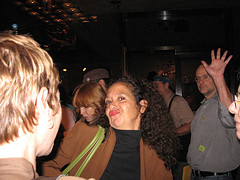
Zoe’s mom strikes a pose for her photo after the presentation
After the conversations, Strauss encouraged people to trade their pictures and get polaroids of themselves beneath the arbor.
My Flickr set of the night can be seen here.


